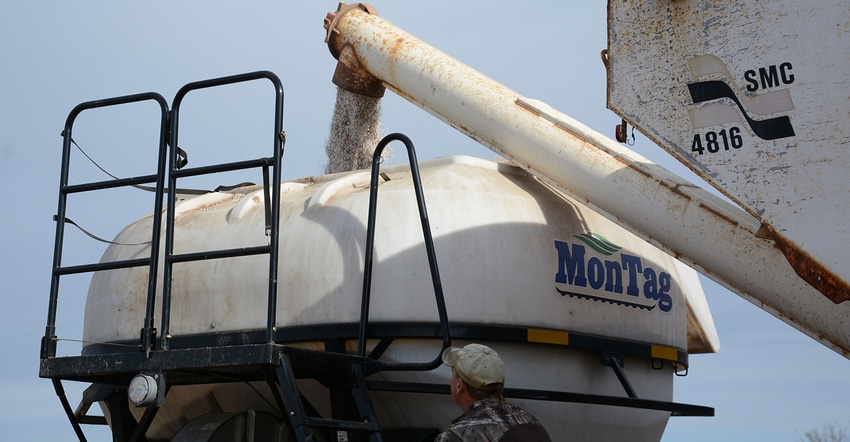April 30, 2018

The Minnesota Department of Agriculture last week released the proposed Groundwater Protection Rule to the public and announced the rule will be published in the State Register on April 30.
An 80-day public comment period on the rule will follow.
The proposed rule, which is based on the Nitrogen Fertilizer Management Plan and the input of farmers and landowners to whom the rule would apply, would regulate the use of nitrogen fertilizer in areas of the state where soils are prone to leaching and where drinking water supplies are threatened.
“When I traveled the state last summer to hear farmers’ concerns, I promised the Groundwater Protection Rule would have a healthy dose of common sense,” said Dave Frederickson, agriculture commissioner, in a news release. “I think we have achieved that.”
Frederickson encourages anyone with interest in the rule to provide feedback through the rule-making process, which includes five public meetings scheduled in July.
The MDA informally published a draft of the Groundwater Protection Rule in summer 2017, and provided an opportunity for public comment. MDA received more than 820 written comments regarding the rule, and more than 1,000 farmers, landowners and other Minnesotans attended a total of 17 public meetings.
Starting April 30, public comments on the Groundwater Protection Rule can be made on the Office of Administrative Hearings website at mn.gov/oah.
After an 80-day comment period, in the fall the Office of Administrative Hearings will review the comments. Then, the OAH will draft a report approving, approving in part, or disapproving the proposed rule. By December, MDA anticipates adoption of the rule and plans to send it to the governor for his signature. The fall fertilizer application prohibition would then go into effect in January 2020.
MDA has thus far scheduled five public hearings on the proposed rule in July:
• 1-6 p.m., July 16. Robert Boeckman Middle School, 800 Denmark Ave., Farmington
• 1-4 p.m., July 18. Stewartville Civic Center, 105 1st St. E., Stewartville
• 10 a.m.-4 p.m., July 19. Minnesota West Community and Technical College, 1450 College Way, Worthington
• 10 a.m.-4 p.m., July 25. River’s Edge Convention Center, 10 Fourth Ave. South, St. Cloud
• 9 a.m.-3 p.m., July 26. American Legion, 900 1st St. E., Park Rapids
More meetings will be scheduled if necessary, according to MDA.
Further details
On its website, MDA offers a list of answers to frequently asked questions. Here are a few of those questions and their answers, edited for brevity:
Why is a rule needed?
The rule is one tool, for specific situations, that is part of a larger strategy to reduce nitrate from fertilizer in groundwater.
Where does the authority for the rule come from?
The authority for the rule comes from the Minnesota Groundwater Protection Act, Minnesota Statute 103H. MDA has the authority to issue administrative, civil and criminal penalties against those who violate the rule under Minnesota Statute 18D.
How will the Groundwater Protection Rule affect me and my farm?
There are two parts to the rule. Each part contains separate provisions. Depending on where you farm, you may be subject to one part of the rule, both parts or neither part.
You are subject to Part 1 of the rule if you farm in a vulnerable groundwater area or in a Drinking Water Supply Management Area that has 5.4 mg/L or higher of nitrate. This means you cannot apply nitrogen fertilizer in the fall and on frozen soils in those areas.
You are subject to Part 2 of the rule if you farm land in a DWSMA with elevated groundwater nitrate concentrations. These areas will be designated a mitigation level 1, 2, 3 or 4.
How will I know if I live or farm in a vulnerable groundwater area that is subject to Part 1 of the rule?
The application of nitrogen fertilizer in the fall or on frozen soils will be restricted in areas with vulnerable groundwater or DWSMAs that are at or exceed 5.4 mg/L nitrate-nitrogen. An area with vulnerable groundwater is an area where nitrate can move easily through soil and into groundwater.
The criteria used to determine vulnerability include coarse-textured soils, karst geology or shallow bedrock. MDA has a map that shows where fall application of nitrogen fertilizer will be restricted. Vulnerable quarter-sections are shown in purple, and DWSMAs are in green on the map.
More detailed maps showing vulnerable areas also are available.
In areas where 50% or more of the quarter-section has vulnerable groundwater or is in a DWSMA, applications of nitrogen in the fall and on frozen soils will not be allowed in the entire quarter-section. If less than 50% of the quarter-section has vulnerable groundwater, the restrictions do not apply.
Are there exceptions to the restriction?
Fall application of N fertilizer will be allowed in vulnerable groundwater areas to establish winter grains planted in the fall; for fall pasture fertilization; for perennial crops; for grass seed production; for cultivated paddy rice; for research on fields 20 acres or less in size, and for growing fall cover crops within a potato rotation.
There are additional exceptions and exemptions related to presence of clay soils with ultra-low permeability, in areas with reduced leaching potential combined with a short spring planting season, and in counties with less than 3% of the land in row crops.
To learn more about the proposed rule, visit mda.state.mn.us/nfr.
Source: MDA
You May Also Like




